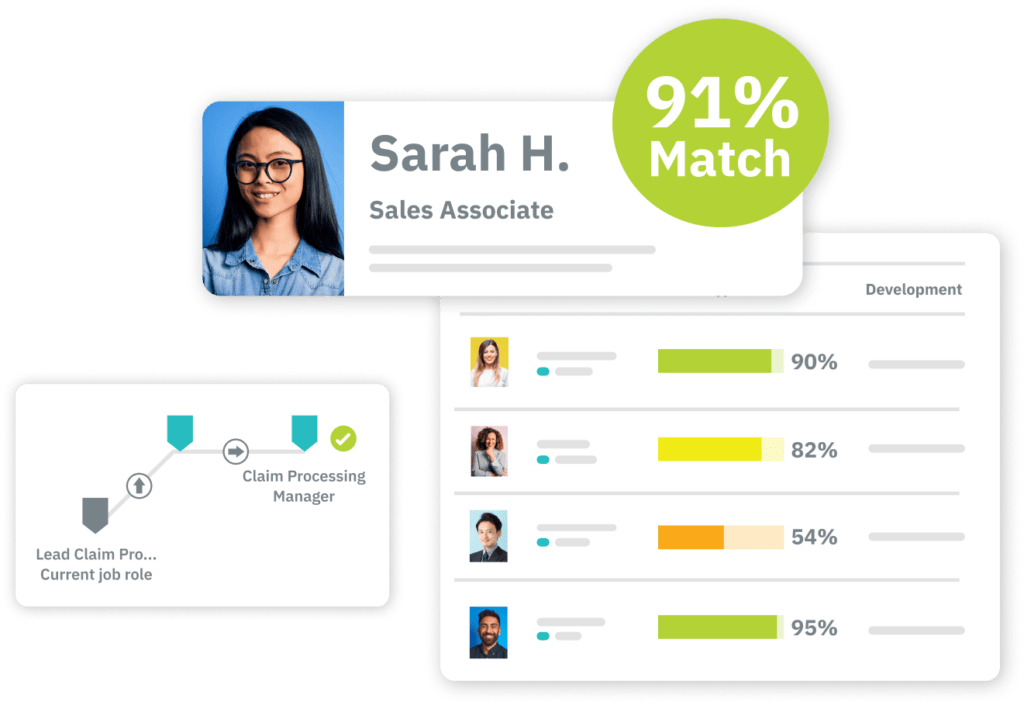Employee Engagement Strategies
Webinar: Career Pathing and Talent Mobility: Driving Engagement and Performance
One of the best employee engagement strategies is to provide your workforce with career pathing and talent mobility. Learn more about how to successfully implement these strategies in our webinar.
Take your company to new heights
Whether your company is grappling with talent management for the first time, looking to modernize outdated tools, or searching for that extra competitive edge, our solution can meet you where you are.


Reveal the true nature of your collective talent
TalentGuard’s Workforce Skills Management platform unifies data, software and ecosystem to unlock complete visibility of skills, the intelligence to make data-led talent decisions and the ability to develop the highest potential in your workforce.
See How Our Platform Helps You Build a Future-Ready Workforce
TalentGuard works best with organizations of 500+ employees in the U.S., Europe, Latin America, and regions within six hours of Central U.S.
Every company is at a different stage. Some need to clean up messy job titles and skills first. Others are focused on readiness, mobility, or succession.
Our bundles are built to match those realities. Pick the bundle that’s closest to where you are today, and we’ll tailor the demo to your needs. If you’re unsure whether we serve your region or use case, email info@talentguard.com and we’ll help you find the best fit.
Job & Skills Clarity
Who it’s for: HR / Talent teams drowning in messy titles, fragmented spreadsheets, and inconsistent role definitions who want a clean, skills-based foundation.
Most consultants take months and charge a fortune to manually build what TalentGuard can deliver in a fraction of the time. With AI-assisted consistency and quality, you get clarity in weeks, not months.
Normalize job titles, define roles and skills consistently, and get out of spreadsheet-only chaos. This bundle gives you a clean, AI-assisted role and skills model that plugs into the systems you already have.
What’s included:
- WorkforceGPT – AI engine to clean and enrich roles & skills
- Intelligent Role Studio – Workspace to manage roles, skills & levels
- Foundational analytics – Basic views of role/skill coverage and consistency
Workforce Readiness
Who it’s for: Organizations with a priority of internal mobility, skill-based development, and answering “Who’s ready now/next?”
Once your roles and skills are clear, this bundle helps you understand readiness, gaps, and internal mobility options. It connects your role/skill model to real people, so you can make better development and movement decisions.
What’s included:
- Talent Insights (selected views) – Readiness & skill gap dashboards
- Talent Assessment – Capture skills, experiences, and proficiency
- Career Pathing – Show employees realistic, skill-based paths
- Development Planning – Skill-aligned development plans & learning recommendations
Strategic Talent Planning
Who it’s for: Organizations with a priority on leadership pipelines, critical role risk, and board-ready workforce stories.
Build on clarity and readiness to manage leadership pipelines, critical roles, and talent risk. This bundle gives you deeper insight into bench strength and connects it to structured succession, performance, and compliance.
What’s included:
- Full Talent Insights – Risk, bench strength & scenario views
- Succession Planning – Plans tied to real capability data
- Performance & 360 – Capability-aligned reviews & multi-rater feedback
- Certification Tracking – Compliance and credential visibility where required
Your Workforce is Evolving — Be Ready for What’s Next
Read our eBook
Learn more about employee engagement
Implementing Career Path Initiatives
Implementing career path initiatives has become a top priority for organizations seeking to retain and develop talent. These initiatives help companies provide clear growth pathways for employees, which, in turn, boosts engagement and reduces turnover. However, the success of such programs relies heavily on having accurate, structured data on skills and jobs. Unfortunately, many organizations […]
Career Development Promises to Unlock Engagement
Career development holds immense promise for motivating and retaining talent. However, too often, it falls short of expectations for both new hires and long-standing employees, costing companies substantial sums in turnover, engagement, and lost productivity. In fact, according to the latest CIPD Employee Outlook survey, one in three employees feel their career progression has not […]
Personalized and Targeted Career Growth
The traditional one-size-fits-all approach to talent management no longer suffices. Organizations must recognize and adapt to the individual needs of their employees, empowering them to take charge of their career paths. TalentGuard is at the forefront of this transformative wave with personalized and targeted career growth. Our self-serve talent solution is designed to help employees […]
Additional information
Employee engagement refers to an employee’s emotional commitment to the organization for which they work. Engaged employees put forth effort voluntarily; they do things that aren’t asked or even expected of them in order to advance the organization, contribute to the team, or better serve the customer. While engagement and satisfaction are often used interchangeably, they don’t refer to the same thing. Satisfied employees can be disengaged.
Drivers of employee engagement, or factors that contribute to emotional commitment from workers, include but are not limited to:
- Effective communication. Employees value transparency into organizational strategy, direction, and metrics.
- Clearly outlined expectations. Team members need to know exactly how to meet the expectations of their leaders, and they deserve to know promptly if there is room for improvement.
- Visible, attainable opportunities for growth. Intentional career pathing and succession planning can help workers visualize their future in the organization and strive to achieve those goals.
- A safe working environment. Striving to create a safe working environment is a critical way to demonstrate the organization’s commitment to its team members.
- Balance between personal and professional life. Employees are more engaged at work when they have the opportunity to take time away from work, to address personal and family needs as they arise, and to fully disconnect when they aren’t at work.
- Access to training and development. Engagement increases when workers are given access to the materials they need in order to grow in their current roles or advance their skills for future promotions.
- Competent leadership. Engaged workers generally have leaders who are competent, secure, empathetic, and empowering.
- Competitive total rewards. How you compensate your team members for the work they do speaks to the value you see in them; competitive pay and benefits drive emotional commitment.
The most successful employee engagement strategies or employee engagement toolkits address these drivers.
Types of Employee Engagement
If you take an inventory of your workforce, each individual will fall into one of several levels of employee engagement. Some will be highly engaged, some will be engaged, and some will be disengaged or even actively disengaged. Let’s explore the types of engagement further.
Highly engaged employees go above and beyond because they want to; they’re emotionally committed to the organization and not actively seeking employment elsewhere. In fact, recruiters are unlikely to coax them away, even with an attractive opportunity. When planning for these employees, leadership should focus on challenge, recognition, and advancement.
Engaged employees are emotionally committed to the company and its goals but could be tempted to leave for another opportunity. Effort spent on your engaged population generally offers a high return; these are performers you want in your organization, so focusing on the drivers that can help retain them is a good investment.
Disengaged employees show up for a paycheck. These are the employees who don’t necessarily express disdain, but who will walk past garbage on the floor without picking it up or who tend to produce results only when watched. They’re clock-watchers.
Actively disengaged employees pose a threat to your entire workforce. Actively disengaged employees put their effort and energy into building armies; they complain about the company, the work, their clients, and their leader. Work is more difficult for everyone when an actively disengaged employee stays on the team.
Some thought leaders will look at only 3 types of employee engagement: highly engaged, engaged, and disengaged. Remember, the best strategy is always to focus on continuing to serve your engaged employees – expend minimal effort on the disengaged.
Creating an Employee Engagement Strategy
One successful approach to creating an employee engagement strategy is to work backward; that is, start with metrics and develop strategies based on known drivers to move the dial forward in those areas.
When developing your employee engagement strategy framework, consider following prescribed steps.
First, measure your current state. Employee engagement surveys and other data, like turnover and retention metrics, can help you identify strengths and areas of opportunity.
Then set goals around these metrics and incorporate them into your strategic plan. Employee engagement directly impacts organizational results and requires the same intentional planning as other strategic initiatives.
Develop an employee engagement toolkit for supervisors that includes inexpensive employee engagement ideas. Types of employee engagement activities might include asking employees about career goals, transparently sharing potential career paths, or implementing frequent and intentional communication channels.
Finally, leverage software to customize action plans based on measurable data, track measures taken, and illustrate changes in real time.
Impact of Employee Engagement
Why are so many organizations investing in employee engagement theories and models? The answer is simple: emotional commitment drives business outcomes. The impact of employee engagement is many-fold.
Organizations with high engagement see higher retention overall; employees are less likely to leave when they feel valued, challenged, and rewarded.
Engagement increases productivity by 17%, likely because engaged employees work hard when nobody is looking. They don’t need continuous oversight in order to perform at the top of their skill set.
Engaged employees are less likely to struggle with obesity and chronic disease and more likely to take care of themselves, largely because their organizations demonstrate care and concern for their well-being through their benefits, events, and communications.
Organizations with an engaged workforce are at substantially lower risk of work-related injuries due to increased awareness of their surroundings and concern for the well-being of themselves and others.
Workplaces with high engagement experience a 41% reduction in absenteeism.
Engaged employees provide better customer service, and consumers spend more money when they get great customer service.
Companies with a high level of engagement among their team members sell more; in fact, sales are 20% higher in engaged organizations than they are in organizations with a disengaged workforce. They make more money, too. Profitability increases by 21% with an engaged workforce.
In summary, employee engagement and motivation are key to organizational success. Leveraging technology can remove ambiguity around these concepts and clearly illustrate the drivers and impact of employee engagement. Organizations that understand why employee engagement is important and take an intentional and pragmatic approach to emotional commitment among staff are likely to perform better than their peers.





